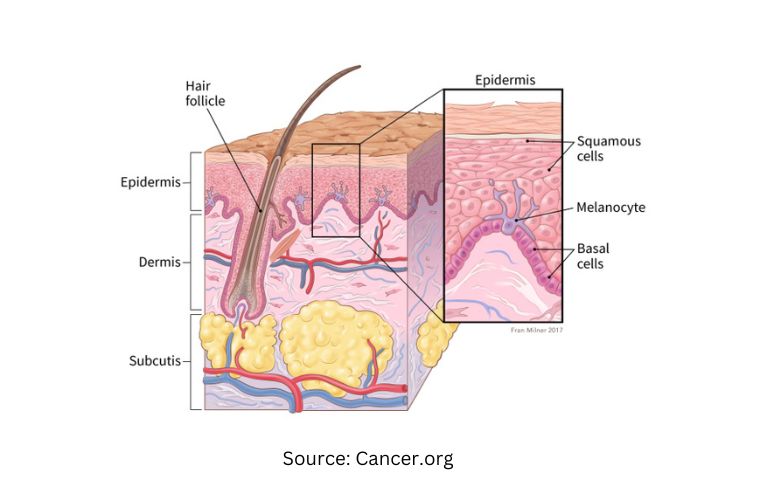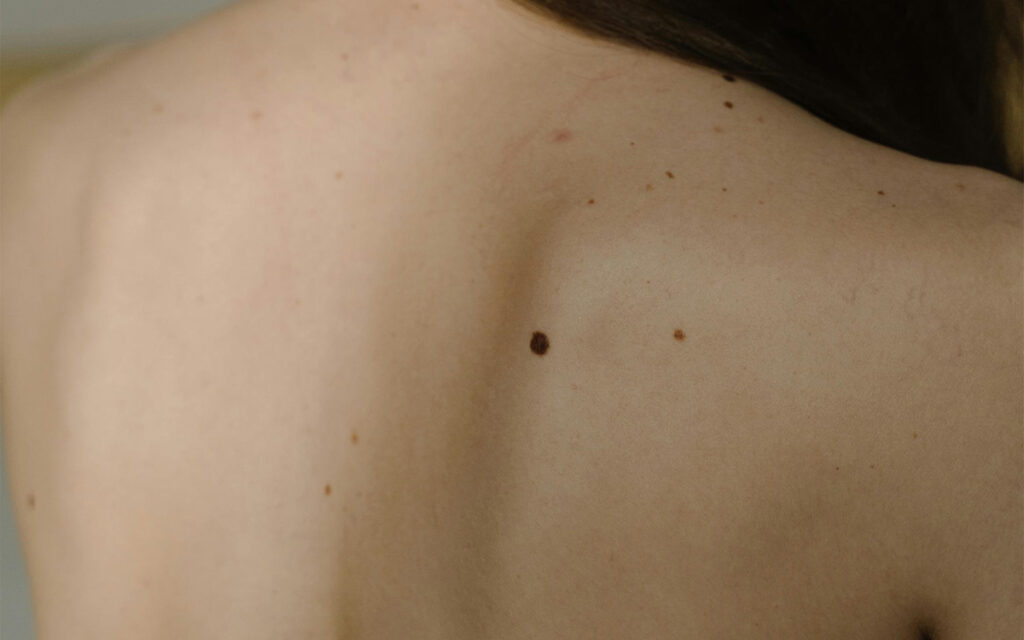Moles, medically referred to as “melanocytic nevi” are pink, brown, or tan colored raised or flat skin lesions of cells that produce “melanin” – the pigment that gives human skin its color. Presence of moles on the skin is not unusual. On average, most people have 10-40 moles on different parts of their skin. They may be present at birth (congenital melanocytic nevi) or may develop in the later parts of life (usually adulthood) as a response to external stimuli (sunlight or UV light), these moles are referred to as acquired melanocytic nevi. Although genetics play an important role in determining the pattern and frequency of skin moles, exposure to sunlight and UV light can also cause you to have more moles and make the ones you already have larger and darker. So, how can you differentiate between a normal skin mole from a skin cancer mole?
While a skincare specialist (dermatologist) is the ideal person to tell the difference between a normal mole and an abnormal one, there are few simple things you can do at home to identify a troublesome mole/blemish/freckle.
Skin Cancer Mole Check
Moles come in different shapes, sizes, and colors. Most of them are usually harmless and do not change, there are some that can grow, change in shape and color and even become cancerous (melanoma). Melanomas can develop from existing moles or they can appear as “new mole-like marks” on the normal skin. The good news is that moles that are considered unusual or “atypical” affect only 10% of the population and only 1 in 10,000 people will have a cancerous mole. With early diagnosis and detection, most melanoma cases can be successfully treated.
While a detailed exam by an experienced Dermatologist is the best way to determine if a mole is cancerous or not, there are a few specific things you can do on your own to spot changes or identify any potential cancerous growth. The ABCDEs of moles can help you analyze moles and check for warning signs that may indicate melanoma. If you see one or more signs, you need to consult your dermatologist immediately.
- Asymmetry – if the two halves of the mole may differ in appearance
- Border – if the outside edges or border of the mole is uneven, distorted, or ill-defined
- Color – if the color of the mole is changing and not consistent or if you see different colors of dark black, blue, red, purple, pink, or brown within the mole
- Diameter – if the diameter of a mole is larger than the diameter of the eraser found on the backend of pencil
- Evolution – if you notice any changes in color, size, shape, or thickness and if this change is rapid or different than you notice in other moles

The ABCDE formula is just a handy tool to watch for general signs, not all skin cancer moles have these traits. Some might be growing quickly but not have other characteristics, while others may not be growing but show discoloration and asymmetry. Your dermatologist will be able to come to a better conclusion after performing a careful history and physical examination and conducting some additional tests such as a biopsy.
Regular skin checks are an essential part of maintaining your health, just like exercise and a balanced diet. If you’re worried about the appearance of your moles, don’t hesitate to make an appointment with a dermatologist. Remember that early detection is the key to the successful treatment of skin cancer. In the same way, postpartum women should regularly check their abdominal area for diastasis recti and seek professional help if necessary. The diastasis recti recovery is possible with the right exercises and guidance, but it’s important to address the issue as soon as possible to prevent further damage to the abdominal muscles. Just like with skin cancer, early detection, and treatment can make a significant difference in the recovery process.
The Treatment Options
The treatment for skin cancer moles depends on a number of factors, such as the type and stage of cancer, the size, location and depth of the melanoma, and your overall health. Surgical removal of the cancerous mole is the most preferred treatment option. A team of specialists including a dermatologist, a pathologist, a plastic surgeon, an oncologist, and a specialist nurse usually participates in these surgeries. In order to make sure that no traces of active cancer cells are left behind, the surgeon may remove a normal margin of the tissue surrounding the mole. If the team of doctors finds that a melanoma has spread beyond the skin, other melanoma cancer treatment options may be used, such as:
- Chemotherapy
- Radiation Therapy
- Biological Therapy
- Targeted Therapy
- Immunotherapy
Knowing your risk factors and being aware of the early warning signs is the best way to deal with skin cancer moles. If you note any changes in the color, size, shape or appearance of your skin moles, don’t wait – consult your dermatologist as soon as possible.
Southbank Medical Centre
Skin Cancer Moles
Doctor Melbourne

